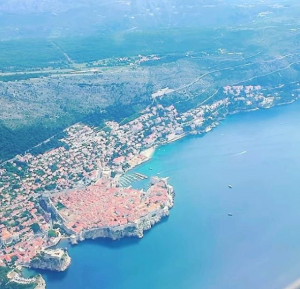
The city of Zagreb, ideally located underneath the mountain Medvednica, is the biggest city in Croatia and also the capital of the Republic of Croatia. The city of Zagreb covers the land area of 641 km2 and it has 1000 000 million inhabitants and 35 city districts. To put it shortly – Zagreb is the centre of economy, traffic, art, science and administration in the Republic of Croatia. Year after year tourists come to Zagreb an enjoy its charming old streets in the medieval Old Town, its green parks and beautiful architecture as well as many other interesting things that this fascinating town has to offer.
Although it is a city with a population of a million, it has nevertheless preserved its individual beauty and a feeling for relaxation.
Zagreb is a town of green parks and promenades with many places to visit in the beautiful surroundings. The old and the new, natural and urban, in a city on a human scale, in Zagreb.Today’s Zagreb came into being as the result of the amalgamation of two medieval settlements, called Kaptol and Gradec.
The first written mention of Zagreb derives from 1094, when a see was established on Kaptol, while neighbouring Gradec was proclaimed a free and royal city in 1242. Some remains of the ramparts that once surrounded the city are still visible. The Baroque reconstructions that the city underwent in the 17th and 18th century changed the shape of Gradec and Kaptol.
The city outgrew its medieval boundaries, the old houses were knocked down, and luxurious palaces for the gentry monasteries, churches, the first parks and country houses were built. Zagreb was established as the centre of government, the economy and culture of the Croatia of the time. In 1890, the development of the town was additionally accelerated by the administrative unification of Kaptol and Gradec into the united city of Zagreb. During the 19th and 20th centuries, Zagreb grew and developed into a real Central European city, enriched with superb architecture, numerous cultural institutions and generations of citizens who made their own contributions to the linkage between Zagreb and other European cultural centres.
After the attainment of national independence in 1991, Zagreb became the capital of the Republic of Croatia, its political and governmental centre. Zagreb entered the 21st century as a contemporary city with a population of a milion.Zagreb has had a tradition of holding fairs ever since 1242. The first international trade exhibition was held in 1864, following the trend of world expositions and fairs set in motion by technological and economic progress.
Zagreb fair is today the leading fair and trade exhibition of South East Europe. Each year thousands of exhibitors from the whole world take a part in some thirty specialised events.The closeness and good connections with the other European capital cities, the abundance of extremely well equipped rooms and halls of all sizes, the high-quality hotels, hospitality, the richness of the culture and entertainment facilities, the excellent cooking and the pleasant climate make Zagreb an ideal congress destination.
Zagreb’s streets and squares are a constant stage for many for many events. During the summer, there are the most varied things going on and making the town still livelier and interesting. The most attractive open-air events include the traditional Folklore Review, the Zagreb summer Festival, the Flora Art Flower Show, the Balloon, Cake and Portugieser Wine festivals, and all sorts of other things. Even the buskers have a festival of their own.
Zagreb is the cultural centre of Croatia. There are some fifteen theatres and a dozen music stages at work in the city. As well as open-air festivals, Zagreb is the host for a number of international festivals such as the New Theatre Festival or Eurokaz, the Contemporary Dance Week, the Music Biennial, the Animated Film Festival and, a relatively new addition, the Urban Festival, which caters for the younger audience and deals with alternative theatre, dance and painting. Many are the artists and performers who have been delighted by the Zagreb audience and the feel of the city.Zagreb is a city of creativity in the fine arts. Many Zagreb artists are famous names on the world art scene.
In the 1960s, Zagreb was home to the world-important movement called the New Tendencies. In the many Zagreb galleries and exhibition spaces you can see or buy works of the most varied forms of artistic expression, always, however, of exceptional artistic value.One of the great passions of Zagreb people is taking part in and following sports and sporting events.
Many Zagreb sports people and coaches enjoy world reputations thanks to the many medals that have kept on being won at the Olympic Games and various world championships. Zagreb often finds itself the host to great sporting events and championships thanks to its high quality sporting infrastructure.
Zagreb abounds in parks and green areas. High above the city spreads the forested Medvednica, the Zagreb mountain, a protected nature park and favourite outing destination for Zagreb people. High class residential quarters surrounded by parks have sprung up on the foothills of the mountain that drops down as far as Ilica, the city principal’s street. The business centre is graced by a series of eight linked parks or gardens called the Lenuzzi or Green Horseshoe. Alongside Lake Jarun stretches a recreational park with kilometres of pebble beaches that attract Zagreb people during the summer months.
The city of Zagreb has continental climate with an average summer temperature of 20˚C and an average winter temperature of 1˚C.
Important Links
- Zagreb Tourist Board – Turistička zajednica grada Zagreba
- Zagreb on Lonely Planet
- Wikipedia
- Zagreb Tourist Board on Twitter
Historical background to Zagreb
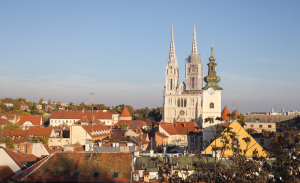
Finding-site in the cave Veternica proofs the existence of life since prehistoric times in the today’s area of Zagreb. However, the name of Zagreb was mentioned for the first time in 1094, when Ladislaw, the king of Hungary, formed a diocese in it. During that time settlement called Gradec also developed on the nearby hill and today Gradec is the part of the city of Zagreb known as the Old Town or the Upper Town. In the year 1242 both Gradec and Zagreb were greatly affected by Tatar attacks. In that same year Gradec was pronounced free royal city by the Croatian-Hungarian king Bela IV because the people of Gradec offered Bela safe haven from Tatar attacks.
In the year 1557 the city of Zagreb found itself in danger again – the Turks were ruthlessly attacking but in that same year Zagreb was mentioned as the capital city for the first time even though Croatian governors did not have their seat in Zagreb until 17th century. In fact, it was the famous Nikola Frankopan who, for the first time in history, choose Zagreb as his headquarters.
In the year 1607 Jesuits from the city of Ljubljana came to Zagreb (they were asked to come to Zagreb by the Croatian Parliament) and in 1669 they already opened an academy where they taught law, philosophy and theology.
17th and 18th century was especially difficult because fire, as well as plague devastated the city of Zagreb a few times. On the other hand, 19th century was a good period for Zagreb because the city grew politically, artistically as well as economically.
The city of Zagreb, just like the rest of Croatia, also spent a certain period being governed by the Austro-Hungarian Monarchy but Croatian Parliament put an end to it – 29th of October 1918 all official connections between Croatia and Austro-Hungarian Monarchy were cut off and Zagreb became the part of Kingdom of Serbs, Croats and Slovenians.
“Surviving” the two World Wars as well as the Croatian fight for independence, in 1991 Zagreb became the capital city of Croatia as well as one of the most interesting and most beautiful cities in Middle Europe.
Sightseeings Zagreb
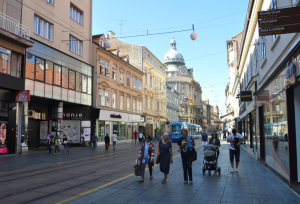
The two major areas that you should visit during your time in Zagreb are Gornji grad and Donji grad. Respectively, these two names translate to the upper town and lower town and basically are the areas in which all of the different sights are located. Everything from restaurants to eat at to religious institutions to attend (the city is home to a massive population of Roman Catholics, just as the rest of the country is as well) are available within these two areas of the city.
One of the major groups of sights that you can visit in Zagreb are museums. These museums showcase much of the history of the city and country that you would not otherwise find from touring. An example of this is the Archaeological Museum of Zagreb, which boasts over 400,000 different pieces for you to look at. Some of these are paintings, some are objects from periods long ago and some are testaments to the recent history that Croatians have experienced. There is also the Museum of Contemporary Art, which showcases contemporary Croatian artistic talent. For a more international flavor, you can also visit the Mimara Museum.
The Upper Town (Old Town)
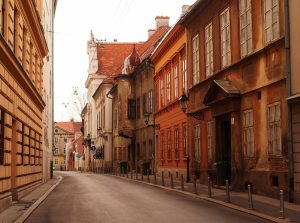
The Upper Town (Gradec) is the medieval part of the city of Zagreb and also the most attractive part as well because the traces of the rich a nd turbulent history of Zagreb can be seen everywhere. One has to pass the Stone gates in order to enter the Upper Town; Stone Gates were built in the Middle Ages and are the only city gates in Zagreb still preserved. the Stone Gates contain a Baroque shrine of the Virgin Mary.
Maksimir Park
In 1794, Zagreb’s Bishop Maksimilijan Vrhovec decided to turn the oak woods, used at that time for timber and hunting, into
a park and give it to the citizens of Zagreb. Maksimir was the first public park in Europe and a grand cultural undertaking filled with its lakes, pavilions and summerhouses.
Ban Jelacic Square
The main Zagreb square used to be called Harmica. From the second half of the 19th C, it bears the name of the famous duke..The round Mandusevac fountain represents the legend of the birth of Zagreb’s name. The spacious square, encircled by palaces and cafés, sometimes transformed from the city’s meeting-place and promenade into a large public stage, particularly during the summer, with the Folklore Festival
Mark’s Square
Mark’s square is the centre of the Upper Town an is dominated by the beautiful Church of St. Mark built in the middle of 13th century. The most interesting feature of this church is its roof covered with coloured tiles.
The Botanical Garden
Antun Heinz created the Botanical Garden in 1889. It is situated in the very center of the city along the street named after Antun Mihanovic, author of the Croatian national anthem. Some 10,000 plants grow in the garden, which is a part of Zagreb’s “green horseshoe,” a group of parks in the center of Zagreb whose groundplan is shaped like a horseshoe.
The Tower of Lotršćak
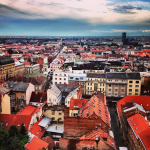
The tower of Lotršćak was built in the middle of the 13th century and from the top of the tower the cannon fires every day at twelve o’clock.
The Funicular
The funicular links the Lower Town with the Upper Town’s cultural monuments.
Jarun
The spacious sports and recreational center at Jarun is an oasis of peace and nature in the heart of city life. The recreational activities are organized around a 2250 meterlong regatta course where international rowing and canoeing races take place. Surrounding the course is a soccerfield, basketball and volleyball courts, a miniature golf course, a running track, a bicycle course and a bocce court. The two Jarun lakes with 2,500 meters of pebble beaches can accommodate almost 20,000 swimmers. During the summer, the center is open from early morning until late night hours when the nightlife begins in nearby clubs, restaurants and cafés.
Medvedgrad
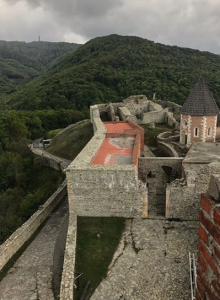
The most important medieval burg in Croatia was built in the 13th C on Medvednica Mountain, first as a diocesan fortress and then as a royal town. Today old Medvedgrad hosts the Altar of the Homeland, a place dedicated to the memory of all the people who have died for the freedom of Croatia.
On the south hills of the mountain Medvednica lies a fortress of Medvedgrad built during the 13th century in order to defend the local population when Tatar attacks started. The fortress of Medvedgrad has an important part in the history of Zagreb but this fortress is also the scene of many legends that are still retold today.
The Zagreb Fair and the WTC
Each year in September, the traditional gathering of world businessmen takes place at the Zagreb Fair, a huge commercial complex of buildings situated in the southern part of the city. Throughout the year, facilities and services available at the Zagreb Fair are ideal for the organization of conferences, round tables, exhibitions, receptions, and cultural and entertainment events. Since 1990, the Zagreb Fair also hosts the International Trade Center, being a member of the New York WTC association with 320 members in 97 countries around the world.
THE ZAGREB FAIR,
Tel: 6503-111, Fax: 6503-116
WTC ZAGREB, Tel: 6503-236, Fax: 6527-260
Zagreb’s Surrounding Area
From the rich tourist offerings we recommend a visit to the castles (Brezovica, Bezanec or Trakoscan), sanctuaries (Marija Bistrica) and thermal springs (Krapinske, Stubicke, Varazdinske and Tuheljske toplice).
- KRAPINSKE TOPLICE
Toplice Hotel — 049/232-165, Health-resort: 049/232-120 - STUBICKE TOPLICE
Tourist Office: 049/282-727, Health-resort: 049/282-328 - VARAZDINSKE TOPLICE
Minerva Hotel: Tel: 042/630-831,
Fax: 042/630-826 - TUHELJSKE TOPLICE
Tourist-Recreational Center
Mihanovic d.d. ,Tel: 049/556-224, Fax: 049/556-216 - BREZOVICA CASTLE — Tel: 01/800-116
- BEZANEC CASTLE — Tel: 049/376-800
- TRAKOSCAN CASTLE — Tel: 042/796-281, Fax: 042/796-420
Tourists Information
THE TOURIST ASSOCIATION OF THE CITY OF ZAGREB,
Kaptol 5, tel. 01/4814-948
TOURIST INFORMATION CENTER, Jurisiceva 1, tel. 01/4814-052, 4814-054
MUSEUMS
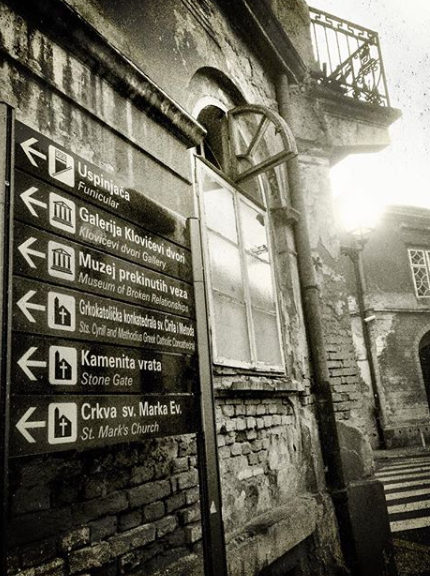
- MUSEUM OF THE CITY OF ZAGREB
Opaticka 20
Permanent exhibition —
weekdays 10 a.m. – 6 p.m.,
Sat. and Sun. 10 a.m. – 1 p.m - MIMARA MUSEUM
Rooseveltov trg 5
Permanent exhibit: The Art
Collection of Ante and Wiltrud
Topic, The Ancient History
Collection, The European Sculpture
and Artistic Crafts Collection of the
Middle Ages and Modern Times
Weekdays except Monday and
Thursday, 10 a.m. — 5 p.m.,
Thursday 10 a.m. — 7 p.m., Sunday
10 a.m. — 2 p.m., Monday closed. - KLOVICEVI DVORI MUSEUM AND GALLERY CENTER
Jezuitski trg 4 - GRADEC MUSEUM AND GALLERY CENTER
Katarinin trg 5
